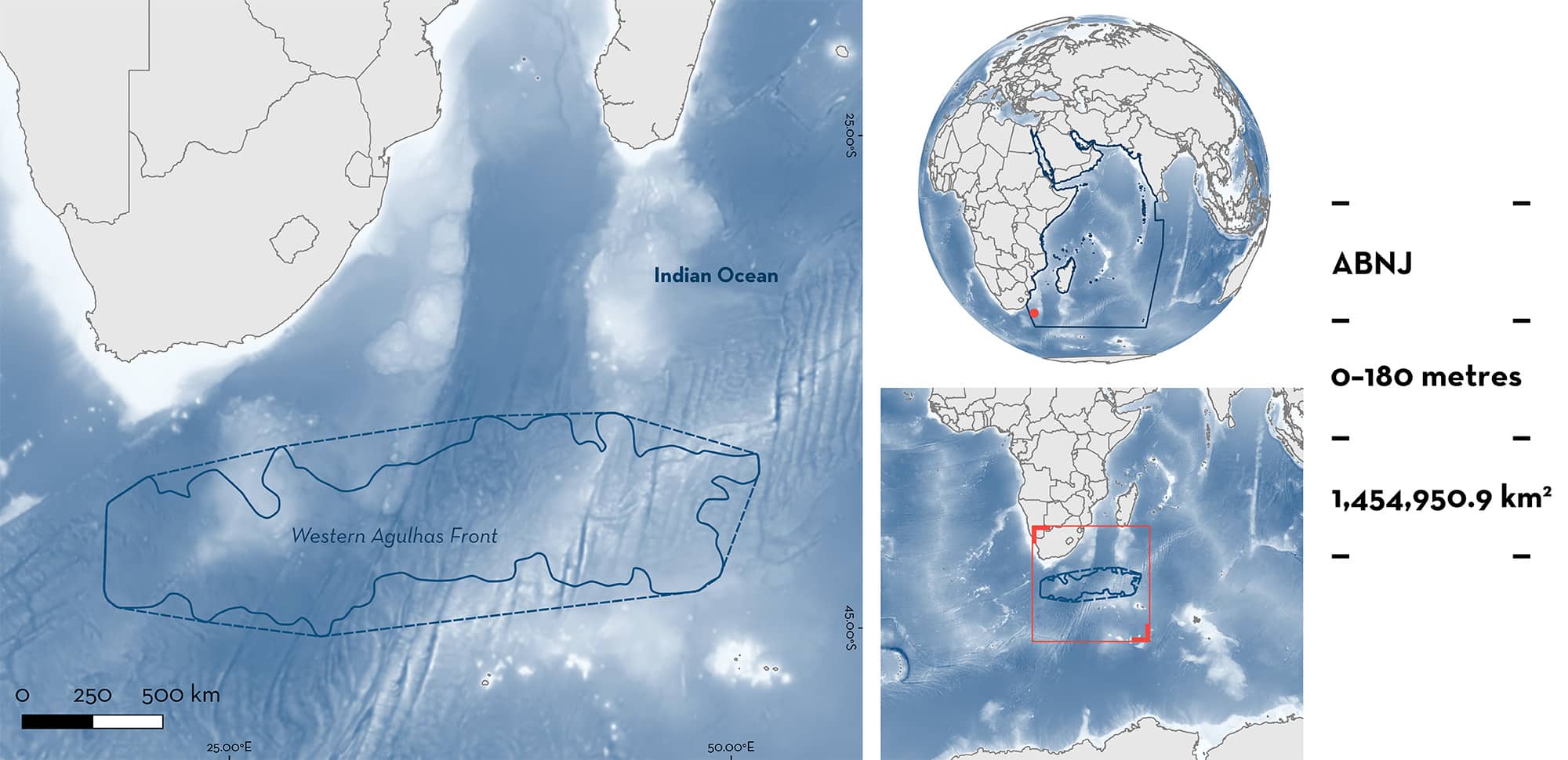ISRA FACTSHEETS
ISRA FACTSHEETS
WESTERN INDIAN OCEAN REGION
Western Agulhas Front
Summary
Western Agulhas Front is a large temperate pelagic area beyond national jurisdiction (ABNJ) in the southwestern Indian Ocean. This area partially overlaps with the Agulhas Front which is the eastward extension of the Agulhas Current. This front connects water from southeastern Africa to subtropical and sub-Antarctic waters. In the south, this borders with the Subantarctic Front. This area is characterised by unusually high productivity compared to other areas beyond national jurisdiction of the Indian Ocean. The area overlaps with three Ecologically or Biologically Significant Marine Areas and three Key Biodiversity Areas. Within this area there are: threatened species (Porbeagle Lamna nasus) and reproductive areas (e.g., Blue Shark Prionace glauca).
Download factsheet
Western Agulhas Front
DESCRIPTION OF HABITAT
Western Agulhas Front is a large temperate pelagic area beyond national jurisdiction in the southwestern Indian Ocean. This area partially overlaps in the west with the Agulhas Front which is the eastward extension of the Agulhas Current, which connects water from southeastern Africa to subtropical and sub-Antarctic waters as far east as the French southern territories of Amsterdam and St Paul islands (Belkin & Gordon 1996; Kostianoy et al. 2004). The Agulhas Return Current has a strong influence on the northern part of the region. The site has high productivity compared to other areas beyond national jurisdiction of the Indian Ocean and supports a significant diversity of biota (CBD 2023a). In the south, this area overlaps with the Subantarctic Front. Habitats include seamounts, transform faults and fracture zones, deep trenches, hydrothermal vents, abyssal plains, and pelagic waters. In this area, the annual mean sea surface temperature is between ∼10 to 17°C (Shukla et al. 2021).
This area overlaps with three Ecologically or Biologically Significant Marine Area (EBSA): Agulhas Front (CBD 2023a); Prince Edward Islands, Del Cano Rise and Crozet Islands (CBD 2023b); and Coral Seamount and Fracture Zone Feature (CBD 2023c). This area also overlaps with three Key Biodiversity Areas (KBAs): Indian Ocean, Western 1 – Marine (KBA 2023a); Indian Ocean, Western 2 – Marine (KBA 2023b); and Indian Ocean, Western 3 – Marine (KBA 2023c).
This Important Shark and Ray Area is pelagic and is delineated from 0 to 180 m based on the depth range of the Qualifying Species in this area.
CRITERION A
VULNERABILITY
The one Qualifying Species within the area is considered threatened with extinction according to the IUCN Red List of Threatened SpeciesTM. The Porbeagle is assessed as Vulnerable (Rigby et al. 2019).
CRITERION C
SUB-CRITERION C1 – REPRODUCTIVE AREAS
Western Agulhas Front is an important reproductive area for two shark species.
From 1967–2014, 77,396 Blue Sharks were collected from longline fisheries operating between 25°N to 48°S, with sizes of 44.8–474.8 cm total length (TL) (Coelho et al. 2018). Smaller animals were mainly reported from temperate higher latitude waters, while mature individuals had a broader distribution that included equatorial and tropical regions. In this area, neonates, young-of-the-year (YOY), and juveniles (51–148 cm TL) were present. Size-at-birth for the Blue Shark is of 35–60 cm TL (Ebert et al. 2021) and size of YOY are reported up to ~122 cm TL (Skomal & Natanson 2003). Further, from 2004–2013, this area had one of the highest relative abundances of Blue Sharks in the Indian Ocean inferred from catch-per-unit-effort (CPUE; sharks/1,000 hooks) in longline fisheries (Tsai & Liu 2015). However, body sizes were not reported.
Kernel density distribution of Blue Shark YOY determined that in the Indian Ocean the largest aggregation was located in this area (Coelho et al. 2018). Thus, this area likely represents the largest known reproductive area for this species in the Western Indian Ocean. The areas with the highest shark CPUE (count/hook) are typically associated with high catches of Blue Shark (78% of total reported by global tuna Regional Fisheries Management Organizations [tRFMOs] from 2012–2020 shark catch globally). Western Agulhas Front overlaps with the region with the highest shark CPUE in the Western Indian Ocean (Burns et al. 2023). This supports findings from a recent study in the Western Indian Ocean, where it has been suggested that pregnant females undertake seasonal migrations (from tropical to temperate waters) within a year to give birth in southwestern productive temperate waters (Zhu et al. 2023).
Commercial fisheries and survey data from pelagic longlines targeting mostly tuna in the Southern Ocean between 1992–2011 were monitored in which 36,247 Porbeagles were captured with an effort of 212,622,118 hooks mostly from the Indian Ocean (Semba et al. 2013). Results indicated that most pregnant Porbeagles (19 of the 28 locations in which pregnant Porbeagles have been recorded) in the Southern Ocean were in the Western Agulhas Front in June and July (Semba et al. 2013). Porbeagles were captured at depths between 0 to 180 m (Semba et al. 2013). A similar behaviour has been recorded for pregnant Porbeagles in the southwestern Pacific Ocean (Francis & Stevens 2000). Porbeagles generally segregate by temperature and latitude, with adults and juveniles in colder waters than neonates and YOY (Yatsu 1995; Semba et al. 2013).
Download factsheet
SUBMIT A REQUEST
ISRA SPATIAL LAYER REQUEST
To make a request to download the ISRA Layer in either a GIS compatible Shapefile (.shp) or Google Earth compatible Keyhole Markup Language Zipped file (.kmz) please complete the following form. We will review your request and send the download details to you. We will endeavor to send you the requested files as soon as we can. However, please note that this is not an automated process, and before requests are responded to, they undergo internal review and authorization. As such, requests normally take 5–10 working days to process.
Should you have questions about the data or process, please do not hesitate to contact us.


